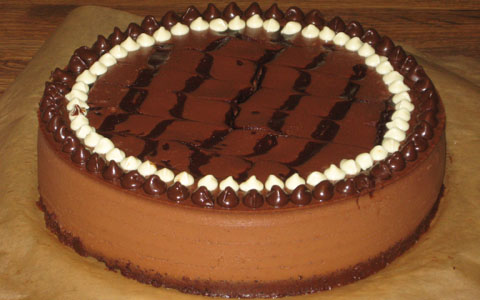|
|
 |
Baked Chocolate Cheesecake—Prototype 20 (7-Way Chocolate):
3-Cheese Blend (1CT-1NC-4YG):
Prepare ahead of time 32 ounces of yogurt cheese, derived from two 32-ounce
containers (that's 64 ounces altogether) of nonfat yogurt. If the resulting
yogurt cheese falls below 32 ounces, add back enough of the whey (that was
strained out from the yogurt) to make up the difference. To this yogurt cheese
combine 8 ounces of whipped, lowfat cottage cheese and 8 ounces of softened
Neufchatel cheese ("light cream cheese").
Grease a 9 1/2" (or 9") pan, but do not wrap foil around it until just
before the batter is added (spreading the crust in an already wrapped pan can
result in greater disturbance to the foil, thus increasing leakage risks).
Chocolate Crust:
4 oz. semi-sweet chocolate, melted
3/8 cup granulated sugar
2 tablespoons cocoa powder
8 oz. (1 cup) 3-cheese blend (see above)
1 teaspoon vanilla
2 oz. finely ground All-Bran
Place the resulting mixture in the greased pan and pre-bake without tub at 300
degrees for 5-10 minutes, depending on the mixture's thickness (closer to 10
minutes if thin enough to be fully distributed across the pan's bottom by gentle
shaking, closer to 5 minutes if thick enough to require spreading out this
mixture by pressing on it with a utensil and/or fingers), then cool enough to
comfortably touch at least the pan's upper sidewall.
Chocolate Batter:
1 3/4 cups granulated sugar
3/8 cup cocoa powder
40 oz. (5 cups) 3-cheese blend (see above)
1/4 cup + 1 tablespoon (5 tablespoons altogether) arrowroot
2 teaspoons vanilla
5 eggs
Double-chocolate sandwich cookies (such as Newman's Own), about 2 dozen
Dark Decoration Batter (thoroughly blend these two ingredients together):
2 tablespoons chocolate syrup (such as Trader Joe's Organic Midnight Moo)
2 tablespoons chocolate batter (see above)
Expect more than 7 cups of the resulting chocolate batter (and reserve 2
tablespoons of this for the dark decoration batter), but do not add this to the
pan all at once (otherwise, the cookies, which are also added here, may end up
floating and/or sinking too much to a single level, due to density differences).
Rather, this needs to be done in five installments. Wrap the pan in foil just
before adding the first installment. Minimize the foil's disturbance in order to
minimize its leakage risk.
For each of the first four installments, gently scoop about 1 1/2 cups of batter
into the pan. Add about 6 cookies (don't bother breaking them up—keeping
them whole is fine and, in fact, recommended), ensuring that they are fully
coated and—as much as possible—immersed.
After adding an installment, bake the pan with its contents at 325 degrees for
15 minutes, in a tub filled with at least 1/4 to 1/2 inch of boiling water. To
reduce spillage risks, do not fill the tub all the way at this point, because
the whole tub-and-pan assembly is going to need to be removed from the oven (in
order to comfortably add contents to the pan) between installments.
For the fifth (and final) installment, gently add the remaining batter to the
pan, but do not add any more cookies. Instead, add the dark decoration batter on
the top surface. From a beaker, pour thick, parallel stripes of this decorative
batter throughout the top surface in the pan. Then pull a knife in perpendicular
directions through these dark stripes in the lighter-colored batter (just deeply
enough for the uppermost installment's surface) in order to produce a wavy,
swirl pattern (see photo below). Do all this as neatly as possible (try to avoid
cutting into the lower installments underneath).
After the fifth installment (including the dark decoration batter) is in place,
return the entire pan-and-tub assembly to the oven. At this point, fill up the
tub generously with boiling water. Resume baking, but with the oven temperature
lowered to 300 degrees, for about another 65 minutes (based upon usage of a 9
1/2" pan).
Afterward, shut the oven off, and leave its door slightly ajar, with the
cheesecake still inside—and in the tub—for an hour. Next, remove the
cheesecake from the oven and tub. Now, for the final chocolate touch, add a
border of chocolate chips, semi-sweet and white, around the edge of this
cheesecake (see photo below). Continue to cool it down at room temperature for
another two hours. After doing so, remove the cheesecake from pan and
refrigerate.

|
|

|

